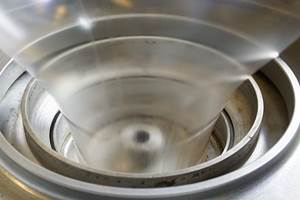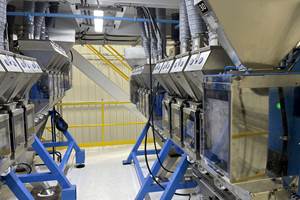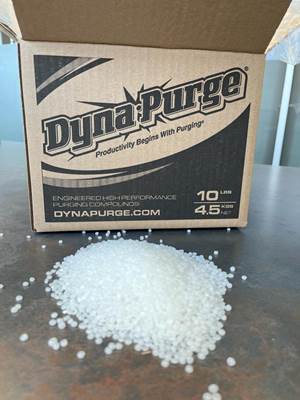Accuracy, Simplicity of Gravimetric Metering Technology Built into Economical New TrueFeed™ Feeder from Conair
New TrueFeed™ color and additive feeders from Conair employ gravimetric (loss-in-weight) metering technology to improve accuracy, while making the units simpler to operate.
New TrueFeed™ color and additive feeders from Conair employ gravimetric (loss-in-weight) metering technology to improve accuracy, while making the units simpler to operate. Unlike volumetric feeders, which have been standard in the plastics industry for years, the new Conair gravimetric feeders are self-calibrating, adjusting automatically for changes in material type, bulk density or pellet geometry. This, in turn, results in easier set-up and greater processing up-time for increased productivity. With prices starting at just $3495, the new TrueFeed units are economical too… less than 25% more than the company’s old-style volumetric BFH feeders. “Twenty years ago, gravimetric blenders accounted for fewer than 10% of all blenders sold in the plastics industry,” recalls Gary Hovis, Commercial Mgr., Blenders & Feeders. “In the last two decades, those percentages have reversed, with very few volumetric blenders being sold outside of certain niche market segments. Volumetric feeders, on the other hand, have held onto their market share for somewhat longer because gravimetric units have been quite expensive. Now that we have been able to get the TrueFeed pricing to volumetric levels, they have the potential to take over the feeder market the way gravimetric blenders came to dominate the blender market in the late 1980s and through the 1990s.” The new TrueFeed gravimetric feeder uses a rotating tube to meter material more consistently and more accurately than the flighted auger used in most volumetric units. The metering tube is driven by a microprocessor controlled stepper motor, which starts and stops more precisely than the conventional DC motors that are common in volumetric feeders. However, the accuracy of the TrueFeed really arises from the fact that the ingredient hopper is weighed continuously. As material is dispensed, the weight loss is registered and the feeder runs until the exact amount has been delivered to the machine feedthroat. Then it stops. If material characteristics (bulk density, particle geometry, etc.) change, the speed of the metering unit is adjusted automatically to compensate. The digital weighing unit is accurate even under high-vibration conditions. With volumetric feeders, on the other hand, users are required to collect and weigh as many as a dozen material samples to determine how long the auger must turn to dispense a given weight. If the character of the material changes, the time-consuming calibration process must be repeated. Even with proper calibration, volumetric units are notoriously inaccurate and processors have traditionally compensated by using more additives or colorants than are really needed. Sometimes these ingredients can cost up to $50/lb or more, so using even a small amount more than necessary can be quite expensive. With the digital precision of the TrueFeed, processors can be assured they are getting just the right amount of color or additive. And in many cases they find they can get by with a lower setting since it is being dispensed so precisely. The basic TrueFeed unit is sized to feed as little as 0.02g/sec (0.07 kg/hr) or as much as 20g/sec (72 kg/hr). For higher throughput requirements, a unit with a larger stepper motor can be supplied to feed as much as 50g/sec (180 kg/hr). The feeder can be ordered with a standard hand-fill hopper or with an integral compressed-air loader. The loader, when supplied, is controlled through the standard microprocessor control that comes with the TrueFeed. The control itself is easy to use. The operator sets the color or additive percentage, enters the part weight and cycle time, and presses the start button. After initial calibration, no calibration is required for accurate, consistent metering. These operating parameters can be stored in memory for easy recall the next time the same job/material is run. The system can store up to 1500 set-ups. A standard communications package is available to deliver material usage data to a central host computer for inventory control or process documentation. When using two feeders on the same molding machine or extruder, this communication port can be used to tie the two units together for improved product quality. For more information, call the New Product Hotline at 1-888-486-6601
Related Content
Reduce Downtime and Scrap in the Blown Film Industry
The blown film sector now benefits from a tailored solution developed by Chem-Trend to preserve integrity of the bubble.
Read MoreNovel System Produces Color on Demand
Ampacet’s FluxQF technology features a quick-dispersion universal carrier with novel machinery that provides automated color blending in quantities down to 50 lb.
Read MoreUnderstanding the ‘Science’ of Color
And as with all sciences, there are fundamentals that must be considered to do color right. Here’s a helpful start.
Read More'Dual Action' Purging Compound Accelerates Color Changes
Shuman Plastics’ Dyna-Purge Division launches Dyna-Purge L, extending its “3X technology.”
Read MoreRead Next
Advanced Recycling: Beyond Pyrolysis
Consumer-product brand owners increasingly see advanced chemical recycling as a necessary complement to mechanical recycling if they are to meet ambitious goals for a circular economy in the next decade. Dozens of technology providers are developing new technologies to overcome the limitations of existing pyrolysis methods and to commercialize various alternative approaches to chemical recycling of plastics.
Read MoreUnderstanding Melting in Single-Screw Extruders
You can better visualize the melting process by “flipping” the observation point so that the barrel appears to be turning clockwise around a stationary screw.
Read More (2).jpg;maxWidth=970;quality=90)


 (2).jpg;maxWidth=300;quality=90)






 (1).jpg;maxWidth=970;quality=90)